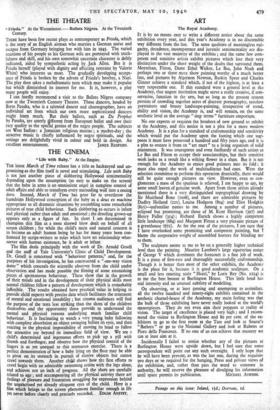ART
The Royal Academy.
IT is by no means easy to write a different notice about the same exhibition every year, and this year's Academy is in no discernible way different from the last. The same qualities of meaningless vul- garity, decadence, incompetence -and juvenile sentimentality are dis- played in the vast majority of the exhibits ; and the same few com- petent and sensitive artists exhibit pictures which lose their very distinction under the sheer weight of the daubs that surround them. Moynihan, Fitton, Dame Ethel Walker, Le Bas, John Nash and perhaps two or three more show painting worthy of a much better fate, and pictures by Algernon Newton, Ruskin Spear and Charles Ginner achieve a standard which, if not of the highest, is at least a very respectable one. If this standard were a general level at th.t Academy, that august institution might serve a really creative, if con- servative, function in the arts, but so long as the present system persists of crowding together acres of discreet pornography, tasteless portraiture and brassy landscape-painting, irrespective of trend, ability and vision, the Academy is, and will remain, on the same aesthetic level as the average " easy terms " furniture emporium.
No one expects or requires the breakers of new ground to exhibit at the Academy, and this notice is not a plea for a more modern Academy. It is a plea for a standard of craftsmanship and sensitivity which would put the Academy upon the footing which one sup- poses it must have possessed a hundred and fifty years ago, and it is a plea to restore it from an " art mart" to a living organism of solid attainment. It was courageous and even foolhardy- of such artists as Le Bas and Fitton to accept their associateships, but their sensitive work looks as a result like a wilting flower in a slum. But it is not enough for the Academy to entice good painters into its fold ; it must also expel . the work of multitudinous bad ones. Were the selection committee to perform this operation drastically, there would still be quite enough pictures on view. However, even so con- glomerate a mass of the spurious is relieved, I am happy to say, by some small leaven of genuine work. Apart from those artists already mentioned there is a very distinguished topographical drawing by Sir Muirhead Bone (too6), and there are admirable pictures by Dudley Holland (221), Louisa Hodgson (804) and Eliot Hodgkin (8I5)-unfamiliar names to me. Among a number of pictures, eclipsed but promising, are those of M. Kent Harrison (307) and Henry Fuller (3j4) ; Richard Enrich shows a highly competent little landscape (684) and Margaret Fitton a very pleasant picture of a greenhouse (672). As for the rest of the pictures, I am sure that I have overlooked some promising and competent painting, but I blame the corporative weight of assembled horrors for blinding me to them.
The sculpture seems to me to be on a generally higher technical level than the painting. Maurice Lambert's large equestrian statue of George V which dominates the forecourt is a fine job of work. It is a piece of first-rate and thoroughly successfully craftsmanship. Though it is better than most of the other exhibits, the Academy is the place for it, because it is good academic sculpture. On a small and less exacting scale " Hazel," by Loris Rey (No. 1224) is to me the best bronze at Burlington House. This little head has real intensity and an unusual subtlety of modelling.
On observing, or at least passing and attempting to assimilate, all the twelve hundred and ninety-eight exhibits contained in the aesthetic charnel-house of the Academy, my main feeling was that the bulk of those exhibiting have never really looked at the world's masterpieces. They do not even aim their popguns at reality of vision. The target of excellence is placed very high ; and I recom- mend the visitor to Burlington House and 8o per cent. of the ex- hibitors to go to the first room at the Tate and look at Seurat's "Bathers " or go to the National Gallery and look at Rubens or Piero della Francesca. If no one of us can achieve that mastery we can at least aim at it.
-Incidentally I failed to notice whether any of the pictures at Burlington House were upside down, but I feel sure that some correspondent will point out any such oversight. I only hope that he will have been present, as was the last one, during the requisite two days or so required for the hanging, Press and private views of the exhibition, and, rather than pass the word to someone in authority, he will reserve the pleasure of divulging his information
until space permits its publication. MICHAEL AYRTON.


























 Previous page
Previous page